
125 years
Miele quality since 1899
The history of Miele over the decades.
Miele History
Two families have shaped the company for 125 years: the Miele and Zinkann families.
In 1899, with 11 employees, four lathes and one drilling machine, the engineer Carl Miele and the businessman Reinhard Zinkann founded a company for the manufacture of cream separators in Herzebrock. Their guiding principle later becomes the business philosophy: 'Immer besser'.


The Miele Story begins in June 1899
In an old saw and corn mill in the town of Herzebrock near Gütersloh, the young company starts producing cream separators with eleven employees.
The first years after the foundation
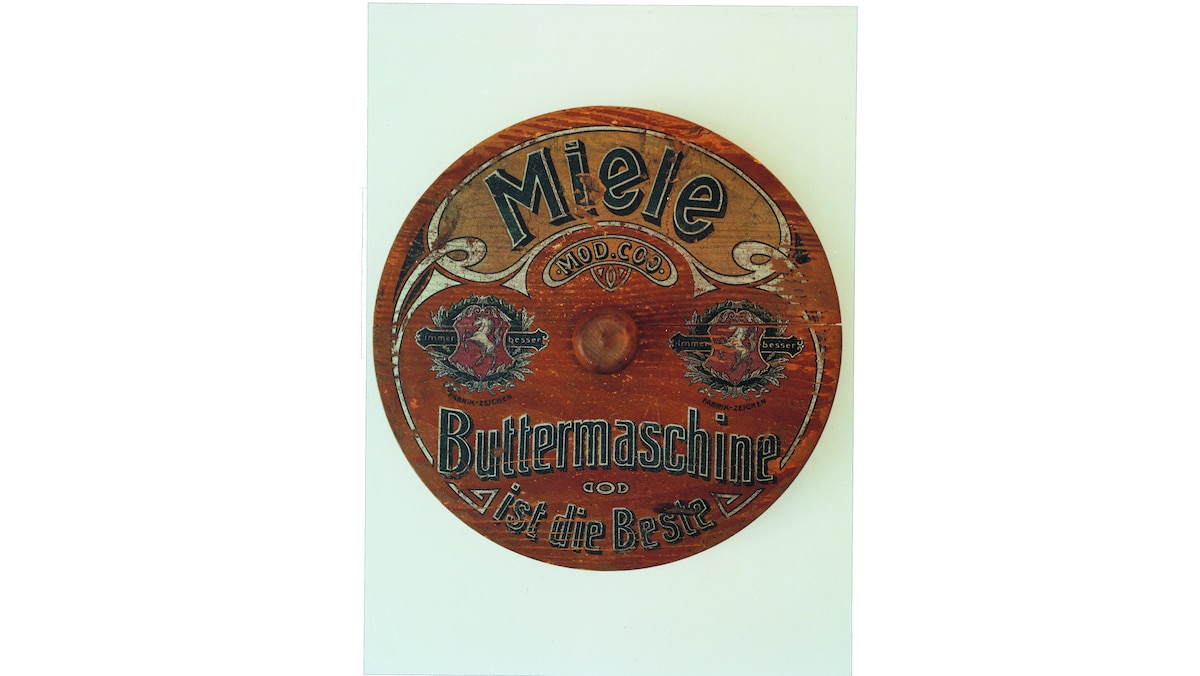
In its second year, the Meteor butter churn was added to the programme and made work even easier on farms, particularly on farmers' wives.

The Model A washing machine with a lid-mounted agitator makes operation much easier. The agitator has a flyweight that maintains the motion and is much easier to move than a simple lever.
The new venture: Vehicle production

Miele's first washing machine with its own electric motor goes on sale in 1910. The same motor also powers the wringer. A release lever allows the wringer to be disengaged from the drive mechanism.

Encouraged by their huge successes thus far, the founding fathers venture into the automobile production. Between 1912 and 1914, a total of 143 cars were delivered at prices ranging from 5,100 to 7,900 marks. Due to the extensive capital investment required by this line of business it was soon abandoned again.

Miele introduces its first water-powered washing machine (No. 40) even before the First World War. At that time, water was considerably cheaper than electricity and could also be collected afterwards and put to other uses (for instance for rinsing).

1915
The Miele hand-cart
Born out of necessity during the war, Miele added hand-carts to its production programme. This product was such a success that it was manufactured well into the fifties.
The washing machine is fitted with an electric motor

The third, completely new model is a washing machine with an attached electric motor that can be plugged into any mains socket. It is the legendary Miele washing machine no. 50.
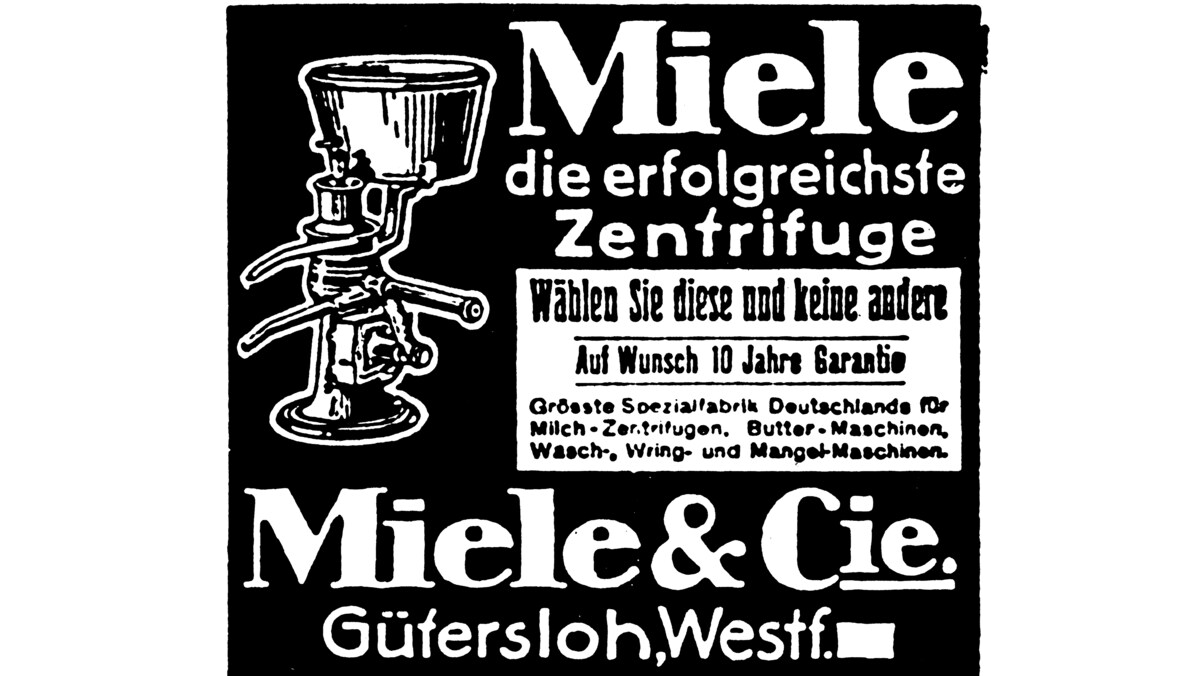
Even then, Miele was so confident of the quality of its products that it offered a 10-year guarantee on request.

1920
The small dairy
Milking is already highly mechanised. Small dairies, consisting of two or three pieces of equipment, process milk all the way through to butter production, all powered by a single engine.
New locations and new product categories

In its quest for a unique identity, Miele initially has focues its advertising efforts on conveying a clear brand profile with easy-to-unterstand information.

In 1924, it finally happened: The expanded Miele factory in Bielefeld started the long-awaited production of bicycles.

In 1925 Miele developed its first coal and gas-powered washing machines. These large-capacity machines were designed for in-house laundry facilities in hotels, restaurants, hospitals, etc. A matching large spin dryer was also delivered.

1931
Modern torpedo-shaped vacuum cleaner
After the canister vacuum cleaner, Miele introduces the Model L, the first vacuum cleaner in the shape of a torpedo, a design that is still common today. In addition to the shape of the head, new features include an attachment for gentle carpet cleaning, rubber buffers and a Bakelite housing.

Miele's cradle washer was launched in 1930, based on the age-old principle of washing: dragging laundry back and forth under running water and beating it by hand. Such a large machine required the use of an electric motor.
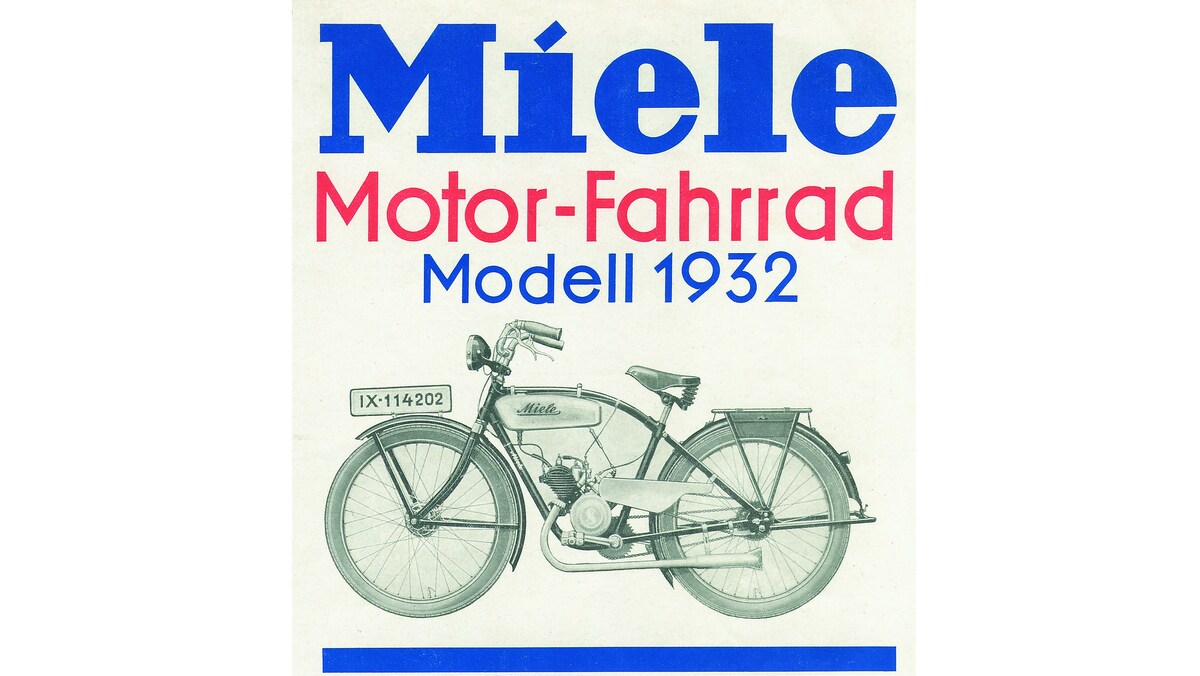
Bicycles are equipped with a motor. Especially for older people as well as doctors, foresters, vicars and postmen in rural areas who travel widely, the Miele motorised bicycle brings welcome relief.

Vacuum cleaner sales now reached significant volumes. New, advanced models, simple operation and attractive prices, supported by intensive advertising, resulted in rapid sales growth.
Miele under National Socialism

Miele under National Socialism
Even before the death of the two founders in 1938 and 1939, their sons Carl Miele Jr. and Kurt Christian Zinkann joined the executive board, supported by their younger brothers Heinrich Miele and Erich Zinkann.
It was their responsibility to steer the company through the remaining years of National Socialism, including the Second World War. For Miele, this meant gradually converting production to different types of munitions. Forced labourers were also deployed at Miele in Gütersloh and Bielefeld to manufacture armaments.
The details of the company's role and the people actively involved in the years 1933 to 1945 have been scientifically researched and published in book form in 2023. The author is Dr Andrea Schneider-Braunberger, managing director of the Society for Corporate History (GUG) in Frankfurt/Main. The title of the book is ‘Miele im Nationalsozialismus’ (German). It was published by Siedler Verlag, Munich 2023 (ISBN 978-3-8275-0188-2).

1949
Miele's 50th anniversary
Miele's 50th anniversary is celebrated on a modest scale. Instead, all employees received a substantial gift of money, all Miele pensions are increased by 20% and a considerable amount is placed into the company's benevolent fund.

The production of household appliances had to be drastically restricted during the war years. In 1940, only about 22,000 washing machines were produced - about 10,000 of them Model No. 55.

An important product in its day was the Miele Bicycle for 'industrial service' - a bicycle built 'to withstand the roughest wear and tear'.

The washing machine No. 122 KVJ is a new development with a lid-mounted agitator and a galvanised steel tub. The covered drive mechanism even features ball-bearings.

1952
The washing machine conquers the apartment
In the fifties, the washing machine leaves the outhouse or basement and moves into the home. This is accompanied by a change in shape as well - it becomes rectangular. This was the advertising slogan for washing machine no. 75: An elegant, decorative exterior and an eye-catcher in any kitchen or bathroom.

The front loading washing machine No. 307 is one of the first to feature a 'porthole door'. For the first time machines are loaded from the front. The washing machine has a new look. It is the sign of the advent of automation in laundry care.
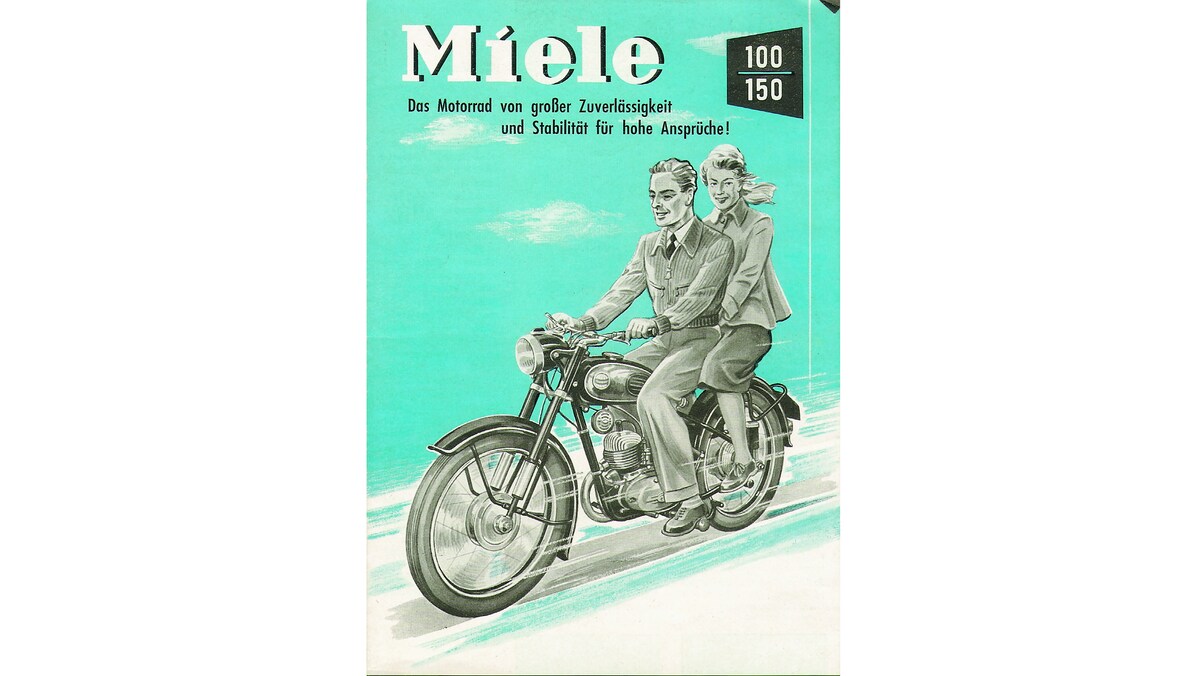
The production of two-wheelers reaches its peak in the mid-fifties. Mopeds, motorised bicycles and motorbikes are produced in ever increasing numbers. Miele's advertising supports this trend with brochures providing detailled information.

In 1958 Miele opens a new chapter in the history of laundry care: The first electric tumble dryer for domestic use leaves the factory.
1960 - 1969

1963
Washing up by hand is a thing of the past
A new dishwasher, the Miele G 45 was launched in 1963. Its exceptional features are: Increased capacity (12 standard place settings), can be fitted thanks to standard kitchen dimensions, stainless-steel wash cabinet, measured detergent dispenser.

The production of two-wheelers slowly comes to an end. The Miele moped K 52/2 Sport is the last new development in this field. The moped has a 47 ccm Fichtel & Sachs engine with pedal kickstarter and is equipped with a three speed gearbox as a standard feature.

Miele enters the hospital markets with special washers. The first model is the G 15 OP Special for cleaning surgical instruments.
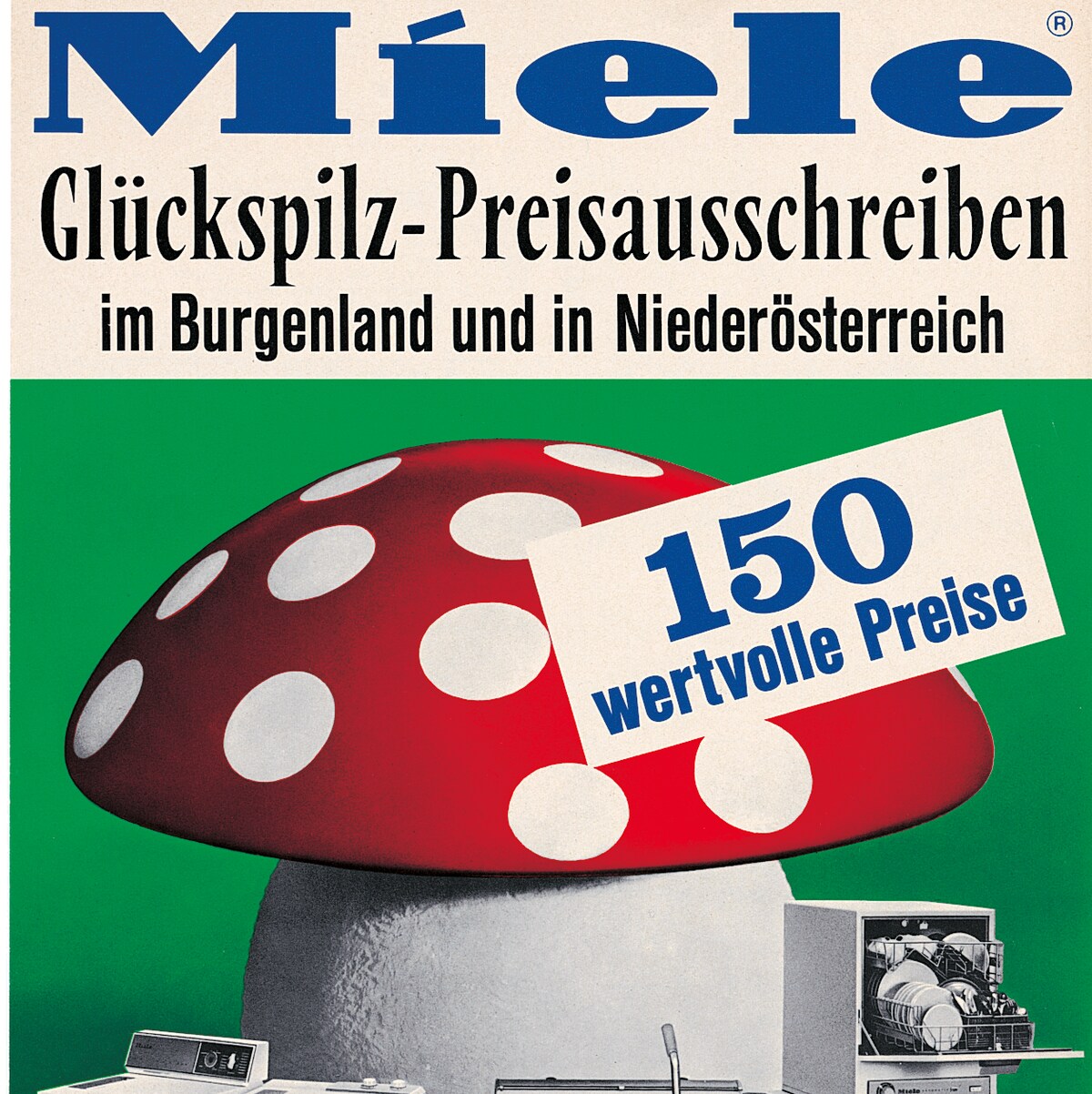
In 1965/66 Miele's very extensive production programme is publicised everywhere with large-scale regional advertising campaigns. The "lucky winners" have to answer questions about the various appliances.

1974
A new generation of built-in cookers
Together with the new generation of kitchens from Miele's Warendorf plant, a new generation of built-in cookers is launched onto the market. For the first time, the design of the appliances was precisely matched to that of the kitchen cabinetry, and their appearance was a perfect match for the Miele kitchen.

Vacuums cleaners are given facelift with models S 180, S 200 and S 204. High suction power of 1000 W and electronically controlled suction power are the outstanding features of the S 204 shown here.

Kitchen production at the new Warendorf plant reaches full speed. The new cabinet fronts made from solid oak, stained in various colours, are a big attraction. But laminate fronts in modern colours are very popular as well.

The microwave era begins. Miele's first product, the Model M 690, is initially a table-top unit that finds enough space anywhere thanks to its small dimensions. Later on, the appliance is also offered as a built-in version.
1980 - 1989

1987
A new level in the dishwasher: The cutlery tray
Under the motto 'Dishwashing at the highest level', Miele launches the first dishwasher with a cutlery tray. Cutlery is washed thoroughly and gently on a third level above the two crockery baskets.

A new generation of computer-controlled washing machines and tumble dryers is launched in 1981. The main advantages of this new Miele class are: 5 kg increased load capacity, faster spin speeds and more environmental friendliness thanks to energy-saving programmes.

A new rotary ironer with roller speed control is introduced in 1982 with the model B 864 E.

The new Miele Museum is opened in 1987. As the oldest washing machine manufacturer in the Federal Republic of Germany, Miele offers a unique history lesson on the development of the washing machine.
1990 - 1999

1996
The Miele car returns to Gütersloh!
The legendary Miele motorcar returns. Following a world-wide search, one of the first Miele motorcars, built in 1912, is found in Norway. After a mechanical overhaul, the car is the pride and joy of the new Miele Museum.

A fully automated distribution centre is opened at the Gütersloh plant. This new link in the supply chain, with a computerised storage system for around 100,000 domestic appliances, ensures that goods are dispatched in a targeted and efficient manner.

Miele also takes a giant step towards satisfying customers by entering the fitted kitchen market. All customers can now choose the colour of their kitchens from a broad range of RAL colours. Customers can order their kitchens in exactly the colour of their choice.

'Update' is the for buzzword around Miele's new automatic washing machines. The electronic controls are designed in such a way that programme configurations can be adapted to take account of changes in fabrics, detergents or fashions, even years after the machine has been purchased.
2000 - 2009

2001
100 years of washing machines: with new honeycomb drum
Celebrating its 100th birthday, the Miele washing machine revolutionises laundry care with a world first: Laundry glides gently through the patented* Miele honeycomb drum on a film of water.
* European Patent: EP 0 935 687

At the TexCare trade fair, Miele presents the new generation of washer-extractors and tumble dryers with the freely programmable Profitronic M controls. With load capacities ranging from 10 to 20 kg, these machines are available in a variety of models. The washer-extractors and tumble dryers with the familiar shield design win several design awards. WfK* certifies exceptionally gentle laundry care. The wool programme in particular, combined with the honeycomb drum, is as gentle as hand washing.

The perfect vacuum cleaner for every household: Light and easy to manoeuvre, packed with practical features, powerful or even cordless, each range has its own charm.

Cleaning and care products from Miele form a system solution which, together with our high-quality domestic appliances, guarantees perfect results every time. The detergents and cleaning agents are perfectly matched to the respective appliances and guarantee outstanding results.
2010 - 2019

2017
The dialogue oven
Miele's new Dialogue Oven is the first to use a new technology in which electromagnetic waves react intelligently to the texture of food.. Meat, for example, is cooked more evenly, retaining its juices. Fish and vegetables keep their fine structure and dough rises much better. Different fresh ingredients for a complete meal can be placed together on an oven tray and cooked to perfection at exactly the same time – and up to 70% faster than using conventional cooking methods.

Miele has been awarded one of Europe's most coveted sustainability prizes for its far-sighted and long-term corporate policy. Miele won the award in the 'Large Companies' category. The jury honoured in particular the company's comprehensive sustainability strategy and the longevity of its products.

Excellent cleaning results and extremely convenient and hygienic emptying of the dust container – these are the outstanding benefits of the Blizzard CX1. In addition, Miele's first bagless vacuum cleaner protects the user from noise levels typical of this product category. In addition, there are the proverbial Miele quality and many clever details not found anywhere else.

With its Generation 7000, Miele is renewing its entire product range of built-in kitchen appliances, from ovens and hob units to steam ovens, coffee machines through to dishwashers. With nearly 3,000 model versions worldwide, the Generation 7000 of built-in appliances also represents the biggest product launch in the company's history to date.
2020 - 2024

2022
Triflex HX2: The new generation of cordless handstick
The new generation of Miele's cordless handsticks, Triflex HX2, offers 60% more suction power than its predecessor thanks to the patented 3-in-1 design, making it the most powerful vacuum cleaner from Miele. The revised filter and dust container with ComfortClean make everyday life with the HX2 much easier.

The family-owned companies Miele and Steelco have joined forces: Both companies are among the world's leading manufacturers of washer-disinfectors and sterilizers for hospitals, medical and dental practices and laboratories. The Italian medical technology manufacturer Steelco has a strong presence in the special segment - new to Miele - of reprocessing components used in pharmaceutical production.

Tackling climate change is perhaps one of the greatest challenges of our time. As a result, industry is under increasing pressure to make its own substantial contribution to finding a solution. Miele is facing up to its responsibility: From 2021, the Gütersloh-based company will be CO2-neutral at all its sites. This includes both greenhouse gas emissions from Miele's own production processes (Scope 1) as well as those generated by its energy suppliers (Scope 2). The aim is to reduce calculated CO2 emissions by 50% by 2030 compared to 2019.

Rebecca Steinhage joined the Executive Board of the Miele Group on July 1, 2022. The former Senior Vice President Human Resources has been with Miele since 2019. In her role as Executive Officer, she will take over the newly created area Human Resources & Corporate Affairs, which, in addition to Human Resources, includes the departments of Sustainability, Communications and Internal Audit. The photo shows the now six-person Executive Board with (from left) Dr. Markus Miele (Executive Director and Co-Proprietor), Dr. Stefan Breit (Technology), Dr. Axel Kniehl (Marketing & Sales), Rebecca Steinhage, Dr. Reinhard Zinkann (Executive Director and Co-Proprietor) and Olaf Bartsch (Finance & Administration). and Olaf Bartsch (Finance & Administration).